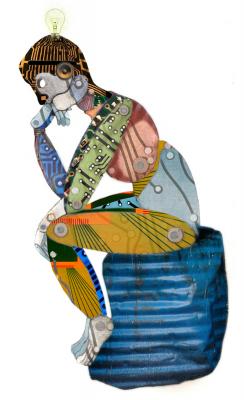
Do your genes determine who you are, or is it the environment that shapes you the most? Given that you’re interested in psychology, I’m sure you have heard of the nature-nurture debate. You probably also know that the right answer is quite cliché: It’s complicated. But what’s so complicated about it?
Do your genes determine who you are, or is it the environment that shapes you the most? Given that you’re interested in psychology, I’m sure you have heard of the nature-nurture debate. You probably also know that the right answer is quite cliché: It’s complicated. But what’s so complicated about it?

Photo by Soňa Višňovská

Photo by Soňa Višňovská
Of course, almost every psychological trait is influenced by both genes and environment, but can’t we just say that genes and environment each contribute a certain percentage? For example, we might say that intelligence is 50% genetic and 50% environmental. Wouldn’t this simple split in percentages be an easy answer to the nature-nurture debate? Unfortunately, it’s not that simple.
One issue is that the relative influence of genes depends on the environment. Consider an imaginary society in which a cruel tradition determines the fate of a child: When the child is born, government officials flip a coin. If it’s heads, then nothing happens, and the child grows up normally. But if it’s tails, then the child’s brain will be deprived of oxygen, and the child will grow up with severe mental disabilities. In such a horrible society, the environment (i.e., the coin flip) would explain almost all of the variance in intelligence. Any person’s intelligence in that society will heavily depend on the result of the coin flip. Conversely, in a society in which everyone has similar environmental influences (e.g., by getting treated equally), genes would explain almost all of the variance. If in such a fair society two people have different levels of intelligence, then this difference must be due to genes because the environmental influence is (almost) the same for both.
“Even when an organism can flexibly adapt to the environment, there must be a genetic basis that enables this adaptability in the first place.”
The (relative) extent to which genes impact a person also depends on age. You might expect that genes become less important as we age since we are exposed to the environment for a longer period of time, but in fact the opposite is the case. As people become older, the influence of genes increases. After taking a closer look, it’s not hard to see why. When we are young, our parents decide almost anything for us, and hence they have a huge impact on who we are. But as we grow up, we can make our own choices more often, and as a consequence our genetic predisposition unfolds, guiding our choice of environment (Plomin, 2019).
Unfortunately, the nature-nurture debate becomes even more complicated when we consider the fact that genes and environment don’t merely add up but interact in peculiar ways. Sometimes certain genes have an effect only if combined with a certain environmental influence. For example, research has suggested that a variant in the FADS2 gene increases IQ, but only if the child has been breastfed (Caspi et al., 2007).
It’s important to note that genes are even important for traits that seem to be entirely dependent on the environment. In other words, even when an organism can flexibly adapt to the environment, there must be a genetic basis that enables this adaptability in the first place. For example, language learning in children is undoubtedly a matter of the environment. Being exposed to speech in infancy and childhood is crucial for language development and depending on the society the child will learn English, Chinese, or a different language. But this doesn’t change the fact that genes determine whether the child is able to acquire a language in the first place.
Additional complexity in researching the influence of genes stems from the fact that it’s not sufficient to merely know which genes there are. Rather, another important factor is how these genes are used (i.e., the specific patterns of genes). Consider the well-known fact that humans share 95 to 99 percent of their genes with chimpanzees (depending on how genetic similarity is calculated). Why are humans and chimpanzees nevertheless so different? As it turns out, it is not because of nurture, but because of how the genes are organized in different patterns. Analogously, compare two different books – let’s say Harry Potter and the Philosopher’s Stone and The Little Prince. Both books use almost the same set of words, but they are still very different books. This is because Harry Potter uses these words in very different orders and patterns than The Little Prince. Similarly, humans and chimpanzees might share an almost identical set of genes, but the distinct patterns of these genes are what makes humans and chimpanzees so different (Ridley, 2003).
All of the aforementioned issues make the nature-nurture debate hard enough, but it gets worse. Many psychological traits (e.g., intelligence) are influenced by many, sometimes even more than a thousand individual genes (Savage et al., 2018). Moreover, for many traits, most genes have not even been identified. Now you might be wondering: But if the genes have not been found, how can we know to what extent a trait is genetic? The answer can be found in twin studies: If two (monozygotic) twins are raised apart, to what extent are they similar with regards to a certain variable? For instance, assume that one of the twins possesses a certain psychological trait (e.g., high extraversion). If the other twin – who was raised in a different family – is much more likely to have that psychological trait as well, then this is a strong indication that genes are involved, even if we cannot pinpoint the exact genes that influence that trait (Plomin, 2019).
“To a large extent genes do not, in fact, determine who you are.”
Before we conclude, I feel compelled to point out another problem with the question as it is phrased in the beginning of this article. Not only does it suggest a simple answer, but it misleads you about what genes fundamentally do. To a large extent they do not, in fact, determine who you are. It is true that in some cases, you are truly determined by a gene, for example in various diseases – e.g., Huntington’s disease. If you have the gene that causes Huntington’s disease, you will almost certainly get it, and if you don’t have it, it’s practically impossible for you to get it. But this is not true for many psychological and even biological variables. For example, body weight is quite heritable – approximately 70% of the variance in body weight can be explained by genes. But even if you have genes associated with obesity, this doesn’t mean that you are determined to be overweight. The point is that genes in this case are not deterministic; they are probabilistic. If you have genes that predispose you towards obesity you can still be of normal weight – it’s just going to be harder. Similarly, school achievement is around 60% heritable, but this does not ultimately determine how far you will make it in education. Just like in the case of obesity, if a genetic analysis shows that you have genes associated with low school achievement, you can still do very well in school, with extra effort (Plomin 2019).
When I was younger, I was often annoyed when the answer to my questions was ‘It’s complicated’. I always wanted to know what exactly it is that makes something complicated. Maybe you’re like me. The issues addressed in this article illustrate this complexity, and yet they barely scratch the surface of the debate. How do twin studies arrive at the estimated percentage of genetic influence, exactly? Why are children from the same family sometimes very different? If you want to know the answers to these questions, you would have to dig deeper, yourself. <<
References
– Caspi, A., Williams, B., Kim-Cohen, J., Craig, I. W., Milne, B. J., Poulton, R., … & Moffitt, T. E. (2007). Moderation of breastfeeding effects on the IQ by genetic variation in fatty acid metabolism. Proceedings of the National Academy of Sciences, 104(47), 18860-18865.
– Plomin, R. (2019). Blueprint: How DNA makes us who we are. MIT Press.
– Ridley, M. (2003). Nature via nurture: Genes, experience, and what makes us human. New York.
– Savage, J. E., Jansen, P. R., Stringer, S., Watanabe, K., Bryois, J., De Leeuw, C. A., … & Posthuma, D. (2018). Genome-wide association meta-analysis in 269,867 individuals identifies new genetic and functional links to intelligence. Nature genetics, 50(7), 912-919.
Of course, almost every psychological trait is influenced by both genes and environment, but can’t we just say that genes and environment each contribute a certain percentage? For example, we might say that intelligence is 50% genetic and 50% environmental. Wouldn’t this simple split in percentages be an easy answer to the nature-nurture debate? Unfortunately, it’s not that simple.
One issue is that the relative influence of genes depends on the environment. Consider an imaginary society in which a cruel tradition determines the fate of a child: When the child is born, government officials flip a coin. If it’s heads, then nothing happens, and the child grows up normally. But if it’s tails, then the child’s brain will be deprived of oxygen, and the child will grow up with severe mental disabilities. In such a horrible society, the environment (i.e., the coin flip) would explain almost all of the variance in intelligence. Any person’s intelligence in that society will heavily depend on the result of the coin flip. Conversely, in a society in which everyone has similar environmental influences (e.g., by getting treated equally), genes would explain almost all of the variance. If in such a fair society two people have different levels of intelligence, then this difference must be due to genes because the environmental influence is (almost) the same for both.
“Even when an organism can flexibly adapt to the environment, there must be a genetic basis that enables this adaptability in the first place.”
The (relative) extent to which genes impact a person also depends on age. You might expect that genes become less important as we age since we are exposed to the environment for a longer period of time, but in fact the opposite is the case. As people become older, the influence of genes increases. After taking a closer look, it’s not hard to see why. When we are young, our parents decide almost anything for us, and hence they have a huge impact on who we are. But as we grow up, we can make our own choices more often, and as a consequence our genetic predisposition unfolds, guiding our choice of environment (Plomin, 2019).
Unfortunately, the nature-nurture debate becomes even more complicated when we consider the fact that genes and environment don’t merely add up but interact in peculiar ways. Sometimes certain genes have an effect only if combined with a certain environmental influence. For example, research has suggested that a variant in the FADS2 gene increases IQ, but only if the child has been breastfed (Caspi et al., 2007).
It’s important to note that genes are even important for traits that seem to be entirely dependent on the environment. In other words, even when an organism can flexibly adapt to the environment, there must be a genetic basis that enables this adaptability in the first place. For example, language learning in children is undoubtedly a matter of the environment. Being exposed to speech in infancy and childhood is crucial for language development and depending on the society the child will learn English, Chinese, or a different language. But this doesn’t change the fact that genes determine whether the child is able to acquire a language in the first place.
Additional complexity in researching the influence of genes stems from the fact that it’s not sufficient to merely know which genes there are. Rather, another important factor is how these genes are used (i.e., the specific patterns of genes). Consider the well-known fact that humans share 95 to 99 percent of their genes with chimpanzees (depending on how genetic similarity is calculated). Why are humans and chimpanzees nevertheless so different? As it turns out, it is not because of nurture, but because of how the genes are organized in different patterns. Analogously, compare two different books – let’s say Harry Potter and the Philosopher’s Stone and The Little Prince. Both books use almost the same set of words, but they are still very different books. This is because Harry Potter uses these words in very different orders and patterns than The Little Prince. Similarly, humans and chimpanzees might share an almost identical set of genes, but the distinct patterns of these genes are what makes humans and chimpanzees so different (Ridley, 2003).
All of the aforementioned issues make the nature-nurture debate hard enough, but it gets worse. Many psychological traits (e.g., intelligence) are influenced by many, sometimes even more than a thousand individual genes (Savage et al., 2018). Moreover, for many traits, most genes have not even been identified. Now you might be wondering: But if the genes have not been found, how can we know to what extent a trait is genetic? The answer can be found in twin studies: If two (monozygotic) twins are raised apart, to what extent are they similar with regards to a certain variable? For instance, assume that one of the twins possesses a certain psychological trait (e.g., high extraversion). If the other twin – who was raised in a different family – is much more likely to have that psychological trait as well, then this is a strong indication that genes are involved, even if we cannot pinpoint the exact genes that influence that trait (Plomin, 2019).
“To a large extent genes do not, in fact, determine who you are.”
Before we conclude, I feel compelled to point out another problem with the question as it is phrased in the beginning of this article. Not only does it suggest a simple answer, but it misleads you about what genes fundamentally do. To a large extent they do not, in fact, determine who you are. It is true that in some cases, you are truly determined by a gene, for example in various diseases – e.g., Huntington’s disease. If you have the gene that causes Huntington’s disease, you will almost certainly get it, and if you don’t have it, it’s practically impossible for you to get it. But this is not true for many psychological and even biological variables. For example, body weight is quite heritable – approximately 70% of the variance in body weight can be explained by genes. But even if you have genes associated with obesity, this doesn’t mean that you are determined to be overweight. The point is that genes in this case are not deterministic; they are probabilistic. If you have genes that predispose you towards obesity you can still be of normal weight – it’s just going to be harder. Similarly, school achievement is around 60% heritable, but this does not ultimately determine how far you will make it in education. Just like in the case of obesity, if a genetic analysis shows that you have genes associated with low school achievement, you can still do very well in school, with extra effort (Plomin 2019).
When I was younger, I was often annoyed when the answer to my questions was ‘It’s complicated’. I always wanted to know what exactly it is that makes something complicated. Maybe you’re like me. The issues addressed in this article illustrate this complexity, and yet they barely scratch the surface of the debate. How do twin studies arrive at the estimated percentage of genetic influence, exactly? Why are children from the same family sometimes very different? If you want to know the answers to these questions, you would have to dig deeper, yourself. <<



